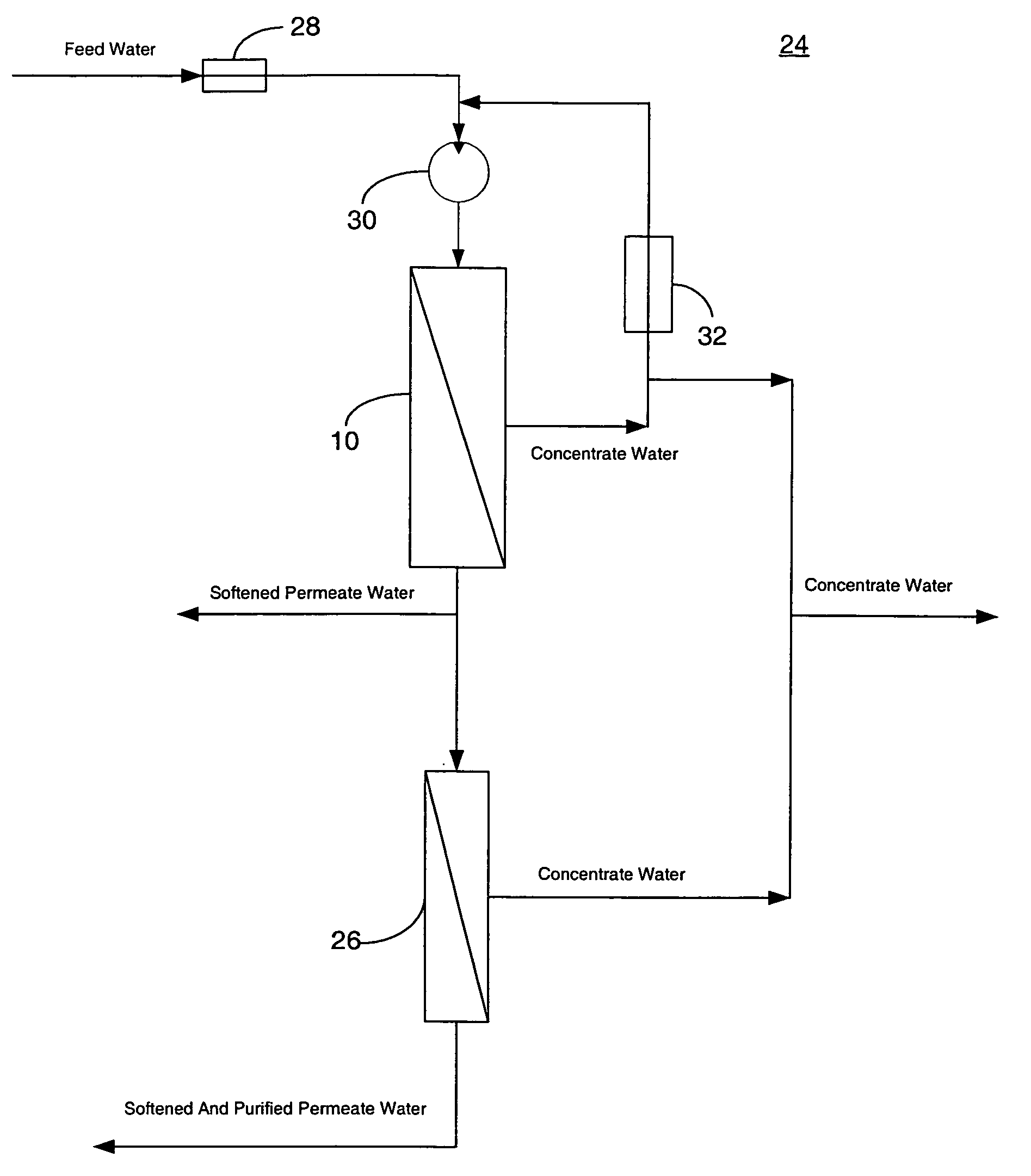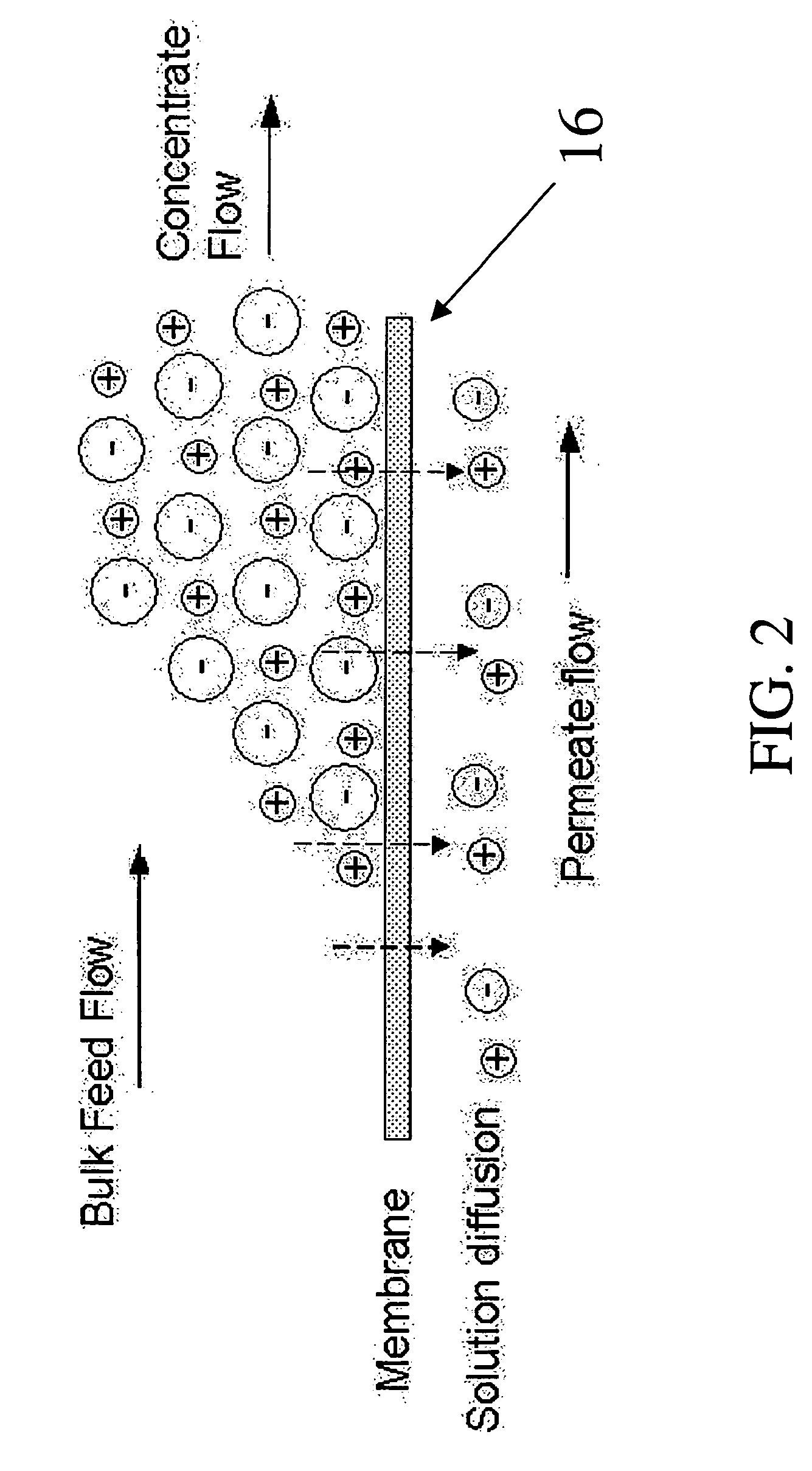System and method for conditioning water
a water conditioner and system technology, applied in the field of water conditioners, can solve the problems of affecting skin and hair, hard water can affect skin and hair, and unattractive film formation on sinks, bathtubs, dishes and cooking utensils,
- Summary
- Abstract
- Description
- Claims
- Application Information
AI Technical Summary
Benefits of technology
Problems solved by technology
Method used
Image
Examples
example 1
[0057] A batch of several 12-inch long GE Osmonics modules having AP-type membrane were screened for several modes of operation such as on-off cycle duration, dosage of scale inhibitor, membrane permeability and salt rejection over time. In addition, a one 40-inch long and 4-inch diameter module polyamide membrane available for production as a large commercial module was tested in a modified Osmonics E-4 unit, where flow rates in gal / min simulate residential operation. Tests were conducted using municipal water from the Town of Niskayuna, New York. Several of the 12-inch modules were taken apart and the membrane intrinsic permeability was measured. The intrinsic permeability for this batch exhibited “A” values ranging from 40 to 50. This is an improvement from another test batch that exhibited “A” values of 25. The 12-inch modules always exhibited a lower overall “A” than the larger 40-inch module due to tighter spiral winding and higher frictional fluid flow losses. Regardless, 85%...
example 2
[0058] A GE Osmonics 4040 module, 4 inches in diameter and 40 inches in length having an AP-type membrane, was tested with scale inhibitor using municipal water from the town of Niskayuna in New York State. This test resulted in the membrane exhibiting a steady “A” value of 40 and 85% water recovery. In addition, the membrane received feed water having 10-11 grains / gal (gpg) of hardness and reduced it to softened water having 3 gpg of hardness, while discharging concentrate at slightly above 30 gpg. FIG. 6 shows the results of this test.
example 3
[0059] Several 12-inch long GE Osmonics modules with AP-type membranes were tested at various process conditions of flow, scale inhibitor dosing, and carbon pre-filtering. Some results of this test were that the membranes allowed approximately 45% of the fluoride ions present in the city water to permeate through the membrane and remain in the softened water. Fluoride ions are typically added to city water by municipalities to prevent dental cavities in children. Conventional reverse osmosis membranes do not allow this as 99% of all the ions are removed. Other results were that the AP-type membranes rejected about 80% of the scale inhibitor added to the feed stream. This result is beneficial as the inhibitor is retained in the concentrate stream being recirculated, thus increasing the contact time with the membrane channels to prevent scaling. Note that the inhibitor is NSF approved and its presence is acceptable in potable water at low concentrations.
PUM
 Login to View More
Login to View More Abstract
Description
Claims
Application Information
 Login to View More
Login to View More - R&D
- Intellectual Property
- Life Sciences
- Materials
- Tech Scout
- Unparalleled Data Quality
- Higher Quality Content
- 60% Fewer Hallucinations
Browse by: Latest US Patents, China's latest patents, Technical Efficacy Thesaurus, Application Domain, Technology Topic, Popular Technical Reports.
© 2025 PatSnap. All rights reserved.Legal|Privacy policy|Modern Slavery Act Transparency Statement|Sitemap|About US| Contact US: help@patsnap.com



